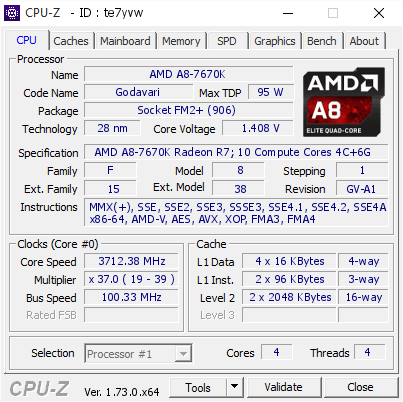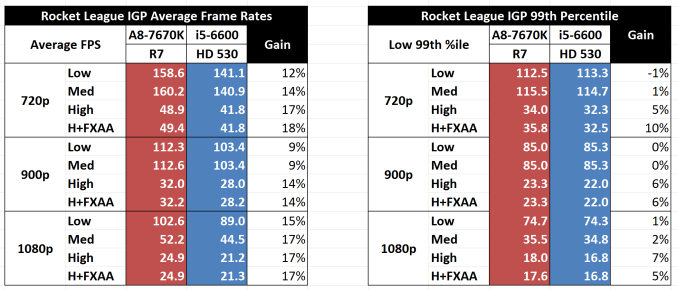The AMD A8-7670K APU Review: Aiming for Rocket League
by Ian Cutress on November 18, 2015 8:00 AM ESTAMD A8-7670K Conclusion
We have tested all of the new AMD APUs as they have trickled into the market, but there are a few obvious points that come up from comments and forums when we discuss them. To start, the base architecture in these APUs, though part of the Kaveri or Kaveri Refresh family, debuted in January 2014, making it nearly two years old. The underlying design that has been iterated upon three times for Kaveri — Bulldozer — is now four years old, released in October 2011. For all intents and purposes, because these processors are AMD’s latest desktop offerings, they are compared to Intel’s latest counterparts.
Despite AMD’s push into using their heterogeneous system architecture platform as a way to accelerate day-to-day tasks that involve any vector calculations (JPEG decode, video playback), as most benchmark workloads will show, the AMD APUs come out slower on the pure CPU aspect, and they're power-hungry due to the 28-nm lithography node on which they are produced (particularly compared to Intel's latest 14-nm node). I was at an event earlier this year where a technology journalist told AMD up front that they considered the 28-nm processors hot and slow, and that users were not likely to be interested in them.
To combat what AMD sees as an pervasive dislike of the platform, AMD has been focusing on three talking points in their marketing message in order to communicate the areas where they believe they have an advantage. This is, by its nature, a bit of a spiel on AMD's part, but at the same time, there are some nuggets of truth in these claims, as illustrated by our benchmark results.
AMD's first talking point is, of course, price. AMD considers their processors very price-competitive, especially for low-cost systems when you consider performance as a function of total system cost. AMD's second talking point is on the power-consumption issue. For some time now, AMD's line has been that they don't believe that most users think about power consumption when gaming, suggesting that for the markets they are targeting, it might not be an issue to begin with. AMD's third talking point is on graphics performance, where AMD believes that their integrated graphics (or dual graphics with an R7 discrete card) will easily win on price and performance, especially for e-sports titles currently favored by budget gamers.
For the validity of AMD's talking points, we can verify Nos. 1 and 3 with our benchmarks, dollar for dollar. Especially when a dual graphics profile for a game exists, the gaming performance will be better for the same price. However, one might argue that relatively few users use a PC just for games, and items such as JavaScript/HTML5 performance for social media interaction is also important, with this being the main barrier low-frequency APUs have to compete against (in comparison to equally priced Intel counterparts). As for talking point No. 2, it's debatable whether users really care about the power consumption of their system during gaming. A personal thought for this would be if the system fans were to spin up, then maybe it would play on the mind, especially if the system is being used to watch a film or play music. But typically, users concerned with this sort of power consumption tend to be over 25 years old and can afford to be more selective with their purchases, as opposed to e-sports gamers on tight budgets. Nevertheless, some users will wholeheartedly disagree.
Ultimately these points lie at the heart of AMD’s dilemma. On one hand, many users will avoid an APU due to specifications or experience, no matter the budget. On the other hand, AMD has a tight space to work in, but there are areas where their APUs hold an edge over Intel's CPUs. The trick for AMD right now is convincing skeptical buyers of this.
If we look beyond today’s review, everyone who cares about CPU performance is hoping that AMD's new microarchitecture in 2016, Zen, allows AMD to catch up to Intel in raw CPU performance. At present, AMD has released slides claiming a 40% increase in IPC for their new design. If AMD can deliver on their performance goals then this should significantly improve their standing as far as x86 CPU performance goes, though this will initially be aimed at the high-performance market. Otherwise for budget users or the e-sports crowd, we will have to wait and see what the Zen microarchitecture brings and how it will be implemented for APUs.
Until then, AMD's APUs still win for that Rocket League style of player, beating any equivalent Intel implementation at the same price. The A8-7670K, with a minor recent discount to $100, is essentially the center point of that APU stack, on AMD's latest process design tweaks. We overclocked our sample to 4.6 GHz, but your mileage may vary.
On a personal note, as you might expect, I build systems for my family. My father, who wanted an audio workstation, had a big enough budget to consider something with many cores and hyperthreading, focusing on low audio latency and a configuration that used software that took advantage of that. I've mentioned in these reviews that I outfitted my 15-year-old cousin-in-law with an APU and a discrete card for a small cheap dual graphics system that probably cost $400 or so. With it, he does school work, talks to his friends and plays a range of MOBA and MMO games without issues. He's rather happy with it.
For future reference, all of our regular benchmark results can also be found in our benchmark engine, Bench.














154 Comments
View All Comments
BurntMyBacon - Thursday, November 19, 2015 - link
@medi03: "I would point you to the fact that Netburst outsold superior Athlon 64s 4 to 1."True, a superior architecture doesn't guarantee better sales, even at better prices. However, Dribble didn't accuse this solution of being inferior for the market it is targeting. He stated:
@Dribble: "No one is buying, ..." and "... the market isn't there."
I don't entirely agree, though (by CPU sales) the market doesn't seem to be very large and is clearly low margin. These are not the processors that will save AMD's business. Zen will likely be the most important CPU architecture in the company's history (whether the design is good/bad/novel/obvious).
medi03 - Thursday, November 19, 2015 - link
I would point you to the fact that Netburst outsold superior Athlon 64s 4 to 1.JoeMonco - Thursday, November 19, 2015 - link
But your silly *facts* don't matter. [Year+1] with the release AMD [Microarchitecture+1] is gonna finally beat Intel! And I know this because my irrational brand loyalty says so!!barleyguy - Thursday, November 19, 2015 - link
You mocking irrational brand loyalty is irony at its finest. ;-)JoeMonco - Thursday, November 19, 2015 - link
I don't see what the irony is supposed. Criticizing AMD doesn't mean I like Intel. ARM is the only real competition that Intel faces.hojnikb - Thursday, November 19, 2015 - link
How much did you spend on that ram ?I bet you could get pentium+4g of ram and a nice 250X (or even 260x on sale) for around the same money.
Thats the problem with apus. They need fast ram in dual channel to be taken advantage of.
yannigr2 - Thursday, November 19, 2015 - link
An A8 7600 costs only $20-$30 more than a Pentium? 8GBs of 1866-2000MHz costs only $10-$20 more than 8GB 1333Mhz? And the card you get in the APU is a little faster than an R7 240 as the review shows.So, in the end you save $30-$40 for the same if not a tiny better gaming experience. This is HUGE if you don't have the money, or if you are a retail shop that tries to create an ultra cheap system that you can market it as gaming and also have one less part in there that makes the assembly easier and also lowers the possibility of an RMA because of the extra part(the discrete card).
AMD can't sell much, because Intel controls the market, people who don't know about hardware buy the Intel brand and individuals who are asked to help others to build such low cost machines, usually exclude AMD from the beginning without even considering it as an option, or even try as hard as they can to make other avoid AMD's solutions. That's even when AMD's solutions are the perfect solutions for specific cases, and those are the same people who constantly cry about competition. My example in my previous post proves that and it was an example based on a last week's case.
silverblue - Thursday, November 19, 2015 - link
Fast RAM which isn't exactly at a premium anymore... at least, right now. I just took a quick glance at HyperX Savage prices on Amazon and a 16GB (2x8) kit was £64 to £65 for 1600 and 1866MHz, and £68 for 2400MHz, with 2133MHz being a little more still. I know, it's a small sample for a single product range, and a lot of these look to have had massive reductions recently, but right now it's not really an expense going with faster RAM.If you play games that benefit from Hybrid Crossfire, it's an option, certainly more than it used to be, however it's still not at the level that I would consider to be worthwhile outside of that particular scenario, and scaling is still minimal even when it does work (in general).
I would like to know what AMD's current CPU market share is. People are forever saying that nobody is buying AMD, however based on popularity on www.dabs.com it appears that the 860K is the top CPU, with the 8320E in second place. The i3-6100 is in third place.
JoeMonco - Thursday, November 19, 2015 - link
25fps? Is that supposed to be impressive?yannigr2 - Thursday, November 19, 2015 - link
You are wrong. I guess two years ago you would have been absolutely sure that this generation consoles wouldn't sell because the hardware wasn't strong enough to run latest AAA titles at the highest possible settings.